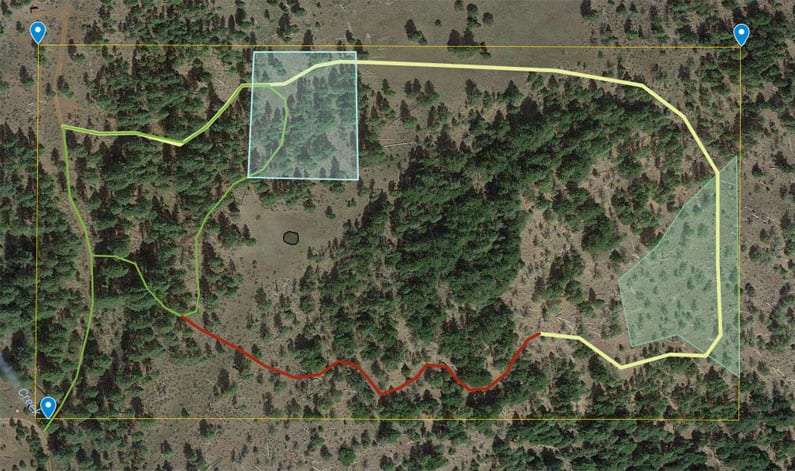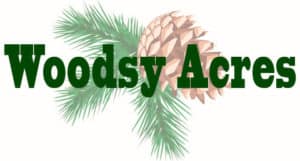
When we bought our forested property this is one of the first things I was required to complete within 60 days in order to keep my taxes in a timber deferred status. I had two options, I could hire a professional forester to gather and write my plan or I could push the envelope and to it myself. I chose the latter and given this task forced me to quickly learn as much about my property as possible.
What is a forest management plan? A forest management plan is a personal statement declaring your objectives for your forested property. It is then followed up by a series of laid out steps, activities, and milestones that will take place in order to meet the stated objectives. In short, a plan is the road map for where you want to be in the near future and beyond. This plan is mostly for you, the landowner and not so much for anyone in the county or state. Typically these get briefly reviewed and the filed away in the event there’s an audit. In other words, this simply fulfills a necessary requirement on the part of a government entity.
Development of the Plan
Something I didn’t think about is forest management is not a short term process, in fact, it can take many years to develop. It’s important to develop the steps needed in order to meet your objectives. Proper planning can help to be more efficient and help to avoid unnecessary costs, delays, or actions as you develop your forest. The amount of time provided for me to complete this plan wasn’t really enough. It takes time to learn everything involved in creating a successful forest management plan. Even with that said, I feel my plan came out better than expected but I also know some things got changed early on. Although not all forest management plans are exactly the same, and every property will present varying aspects, here is a description of how our plan was laid out but doesn’t cover every situation that might be required for you with your plan. Hopefully, this might help you to be aware of certain topics that could be required if you have to create one. Check your local county and state requirements for the proper format and content for your forest management plan.
Deliverables
Once completed the deliverable is a saleable portfolio of your property if you were ever to decide to sell it. Any good property plan never ends until the day you sell the property. So keep in mind that as long as you own your forested property the planning process does not stop but continues over time. As time passes things change, new information becomes available so it’s important to keep a plan up to date. As with my plan I made milestones where I would review and update my Forest Management Plan and resubmit it where needed. Disclaimer, some of the words, categories, and sub-categories come from our local county with the assistance of the state.
First The Cover Sheet
To start with there is a cover sheet that provides information about the landowner such as name, address, city, email, number of acres, county name and state. Also, there’s the parcel number and location of the property.

Objectives
Next is a landowners objective which describes in summary what your plans are with your forested property. For instance, I stated that my plan is to thin existing trees, remove brush, remove damaged trees and replant as necessary. I also stated that my long term and short term goals are the same which is to promote a healthy forest for future timber production for commercial profit through timber sales.
Property Description and Overview
This area describes the number of acres and approximate distance to the nearest township. The description continues by explaining how to get to the property from that closest town. Any other features such as the property are behind a locked gate can also be mentioned here.
It can also describe any types of creeks, rivers, or wetlands on the property along with the altitude and the average annual precipitation.
Resource Descriptions and Management Practices
Then for the plan, I had to create nine (9) resource categories. In each of these categories, there can be several group categories with two subcategories, Resource Conditions and then Management Practices/Recommendations.
Category 1 – includes the following topics.
Forest Health
How does the forest appear, healthy or does it need improvement.
Describe any damage due to insects, diseases or extreme weather conditions such as a drought.
Wildfire
Is this property subject to any local or state fire protection assessments?
Are there any pockets of overpopulation of trees needing thinning out?
What access roads are available. Describe any of those roads or trails.
Invasive Species – Identify any plant species that are considered invasive to the area. This will most likely take a little researching.
Category 2 – includes soils on the property.
To learn about the types of soils in your state area visit this website and select your state: https://www.nrcs.usda.gov/wps/portal/nrcs/surveylist/soils/survey/state/?stateId=WA
If you want to download soils data from your state in the U.S., you can do it for free here: https://websoilsurvey.nrcs.usda.gov/app/WebSoilSurvey.aspx
There is a learning curve, but there is help available from the site in this category:
Identify the different types of soils on your property and then describe such as, ITAT Series
“The Itat series consists of very deep, well-drained soils formed in residuum and colluvium derived from basalt mixed with minor amounts of loess and, in places, old alluvium. Itat soils are on hills and plateaus. Slopes are 5 to 45 percent. The mean annual precipitation is about 23 inches and annual temperature is about 48 degrees F.”
From: https://soilseries.sc.egov.usda.gov/OSD_Docs/I/ITAT.html Discuss the nature of the soils and any resource concerns that can affect forest management activities. (Much of this can be located at the URL provided above.)
Category 3 – includes the following topics.
Water Quality – Talk about possible impaired waterways or failing stream banks.
Fish Habitat – Are there currently impaired or blocked fish passages? Describe
Wetlands – Describe any wetland and riparian areas.
Corrective Practices – If it applies describe corrective practices to restore, improve, or protect riparian areas, which is a narrow strip of land adjacent to wetlands, ponds, streams, and rivers. Depending on the location it’s sometimes just the greener area adjacent to the water area. Whereas, in other locations, it could be plant life that’s adapted to a wetter environment. The riparian areas are important for healthy watershed as well as habitat for wildlife.
Category 4 – includes the following topics.
Forest Inventory – Describe each tree stand in as much detail as possible. What species, age, and tree diameters at breast height.
Timber – What is the quality of the trees describe the understory vegetation.
Wood Products – Describe any types of current wood products, quality, and value currently and in the future.As part of management practices mention any possibilities of any reforestation or afforestation plans.
Category 5 – includes the following topics
Property Access – Describe in as much detail as possible all current vehicle access onto your property. Is there just one access means or multiple access points, if so be sure to describe them all.
Roads and Skid Trails – Continue to describe any other existing roads or skid trails that are on your property. Also, do any of these roads or trails cross any water and if so is that water forged or is there a bridge or culvert.
In some cases such as ours, there is an easement involved with gaining access to your property. If this is the case describe that easement and any restrictions or road use permits. If there’s a gate be sure to mention that too.
Category 6 – includes only the following topic.
Wildlife – List all the wildlife that is known or been seen on your property such as deer, bear, cougar, elk, moose, bobcat,
Category 7 – includes the following topics.
Protection of Special Resources – Describe any known special resources that might require special protection. This could be any number of things such as native, historical, or important sites. If there are none then state there are no know items.
Threatened, Endangered, Animals or Plants – Make a statement about any observed or known plant or animal endangered species.
Category 8 – includes only the following topic.
Aesthetics and Recreation – Talk about anything you might plant or remove to help the property look appealing. I mentioned in my plan that our family enjoys working outdoors so we’ll have a spot for a travel trailer. You can also mention the activity of riding your ATV on soon to be trails and roads. It’s okay to enjoy your property and this is the place to mention that.
Category 9 – includes the following topic.
Carbon Sequestration – In this area, which seemed to be a new category, I mentioned understocked, unstocked, and overstocked areas of trees. Then stated that over time the understocked and unstocked areas will be restocked. Then for the overstocked areas I mention thinning those areas.
Resilience to Climate/Weather-Related influences – Here I talked about the types of trees growing on the property and their vulnerabilities. Mentioned that the fir and pine trees do well in drought areas but are susceptible to the bark beetle.
SCHEDULED TIMETABLE OF EVENTS
At this point, your plan is nearing completion. The next thing to do is set up a “Management Plan Implementation Timetable”. Or it could be called an “Activity Plan”. The idea is to set up at minimum a five-year plan of things you plan on getting completed. More years could be required depending on the requirements in your area. I projected out for 20 years with scheduled change reviews every five years for adjustments. The thing to keep in mind is to not bite off too much in a single year. Managing a forest is not simple or easy work so be open-minded to change and some disappointment. As humans, we tend to make our plans much greater than our budget or time available.
Here’s an example of the Management Activity Plan.
Year 1 – 2017 (Applies to # of acres)
- A) A completed Forest management plan
- B) Brush removal Section 1 on map
- C)
- D)
- E) Maintain bookkeeping
Year 2 – 2018 (Applies to # of acres)
- A) Pre-commercially thin trees Section 2 on map
- B) Clear understory Section 2 on map
- C)
- E) Maintain bookkeeping
This will go on through whatever number of years you’re planning.
Other items to include could be aerial views of your property that show’s nearby landmarks, roads, or highways. Another view of your property with contour lines that indicate changes in elevation could be helpful. Along with other aerials of your property with marked out sections where you plan to work each year. You could also include a map indicating any existing and potentially new roads or trails.
Hopefully, this will help you to have a clearer idea of what a forest management plan involves and prepare you with creating your own.
Thank you for reading this a be sure to check out other articles on this website.
